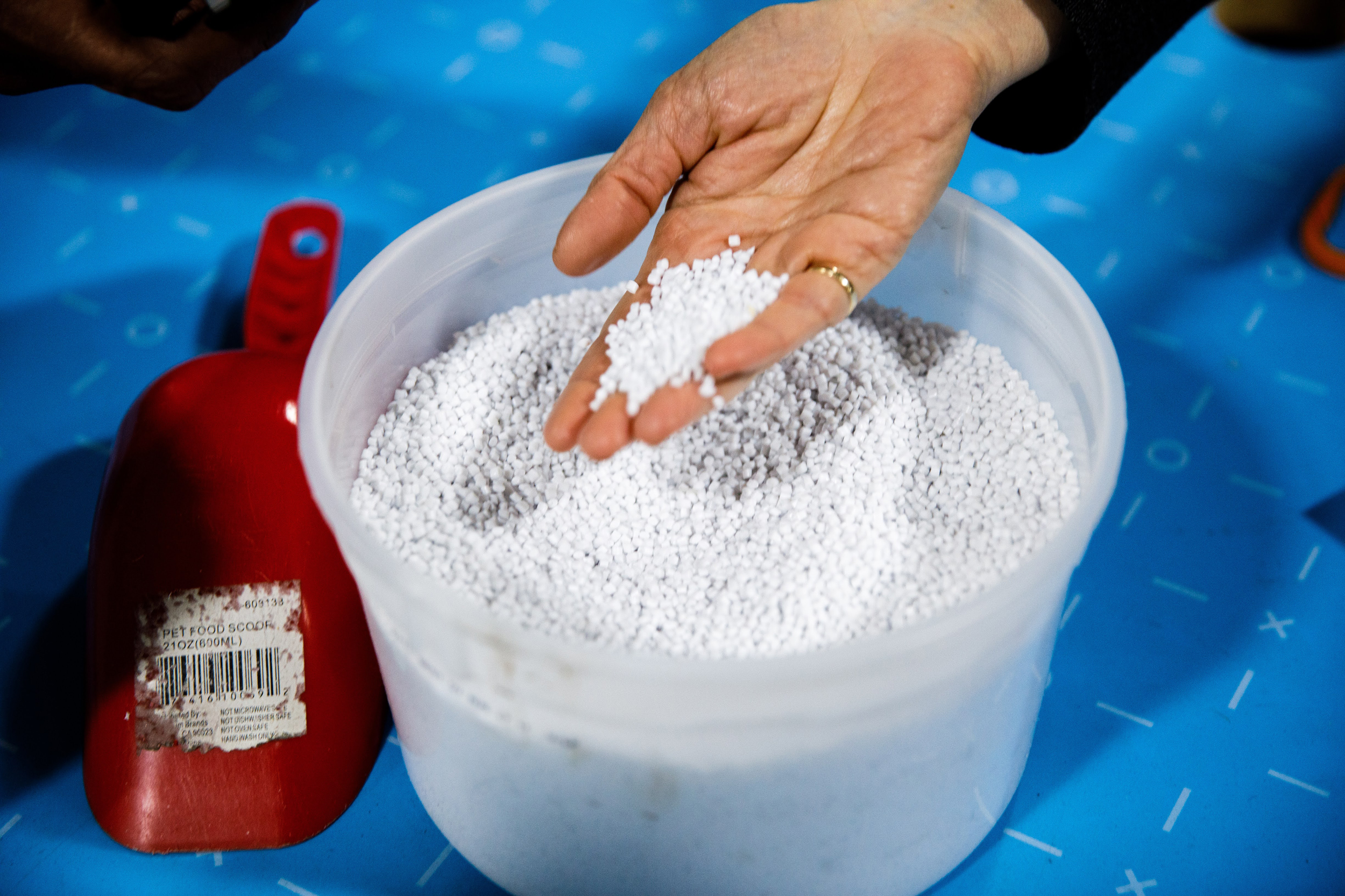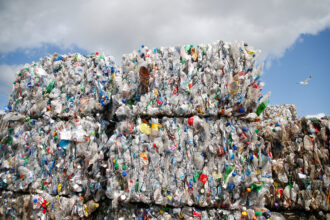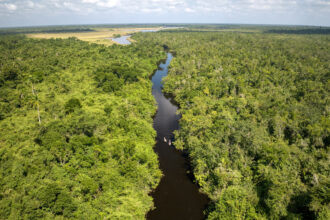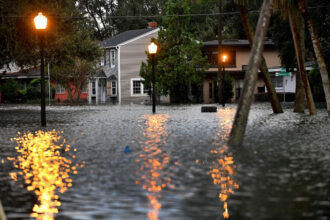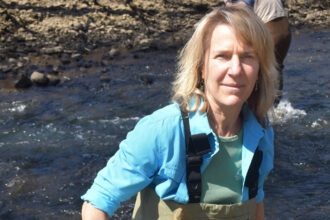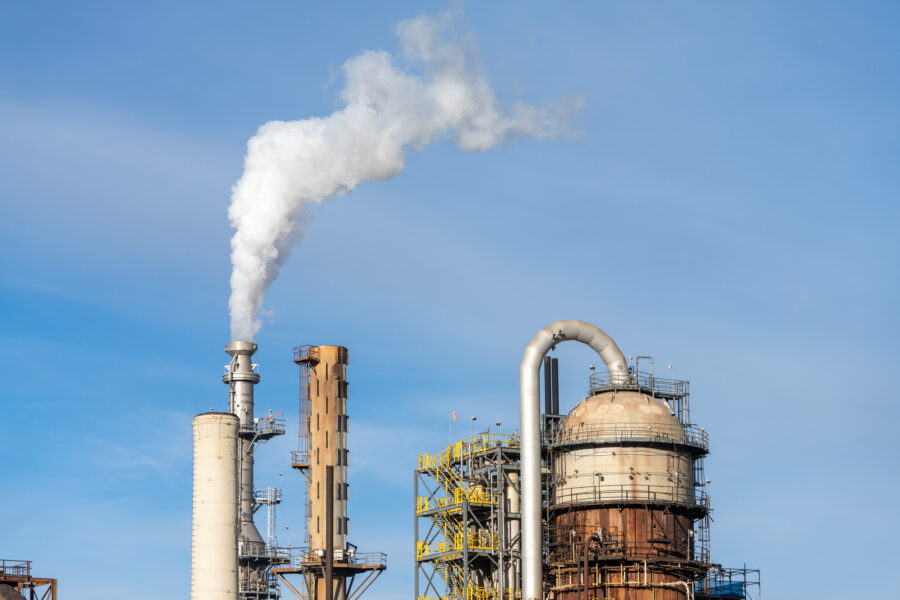PHOENIX—Dozens gathered in an industrial area of the nation’s fifth-largest city in early February to tour a recycling facility billed as a potential solution to the world’s plastic crisis. As the visitors listened, a wall of bins 100 feet long and 30 feet wide stood behind them, filled with just a week’s worth of plastics from local Goodwills.
The plan, city leaders, experts from Arizona State University and community partners said, offered not a revolutionary technology but a rethinking of how the plastic recycling industry works. Common plastic products that people don’t typically recycle—think of your child’s obsolete car booster seat or broken toys—would be collected at local Goodwill stores and sent to this new “microfactory.” Here, they’d be washed and shredded, melted down, and then turned into pellets. From there, they can make products and sell them to the local community—items like skateboards and furniture—or just sell the pellets to larger manufacturers.
Put it all together and it could be part of a circular economy that makes products out of waste materials rather than using new natural resources, with all stages of the plastic recycling process taking place under one roof, employing locals and helping to minimize the amount of traveling and emissions needed to turn a piece of broken plastic into something new rather than waste in a landfill or the world’s oceans. If they could make the microfactory work in Phoenix, the tour organizers said, it could spread a new way of recycling around the globe.
“The hope is to have multiple factories that are distributed so that you can also cut down on how much goods have to travel,” Phoenix Mayor Kate Gallego told Inside Climate News. “Today we’re celebrating the first facility. If the proof of concept is successful, then it’ll grow into a network that I hope will extend worldwide.”
However, recycling plastic is no easy task. Environmental Protection Agency data from 2018, the latest from the federal agency, puts U.S. plastic recycling at nine percent—far below the recycling rates for paper and glass. More recent studies have found the recycling rate in the U.S. may be closer to just six percent. And new research from the Center for Climate Integrity found that plastic producers have known for at least 30 years that widespread recycling wouldn’t work financially or from an engineering standpoint.
“Despite their long-standing knowledge that recycling plastic is neither technically nor economically viable, petrochemical companies—independently and through their industry trade associations and front groups—have engaged in fraudulent marketing and public education campaigns designed to mislead the public about the viability of plastic recycling as a solution to plastic waste,” the report’s authors wrote.
But the industry’s promotion of recycling has led the production of plastic to continue rapidly, spreading plastic pollution found on the summit of Mount Everest, Antarctica and at the bottom of the sea. The vast majority of what’s made ends up in landfills, rivers, lakes, oceans and in the food and water people eat and drink, leaving experts concerned with the long-term risk to humans. Even when plastic can be recycled, research has found the process can turn as much as 13 percent of the incoming waste into microplastics, the tiny particles that end up everywhere.

“We cannot recycle our way out of this problem,” said Jennifer Congdon, deputy director of Beyond Plastics. “We have to reduce plastic production.”
Plans to address plastic waste are often controversial, and Phoenix is no stranger to criticism. Last year, the city announced it was sending plastic waste from the Super Bowl, which nearby Glendale hosted that year, to a facility in Mexico, where critics called it “waste colonialism,” Grist reported.
The microfactory has earned more support, with the backing of plastic recycling industry groups, university faculty and local community groups for its ability to keep all stages of the plastic recycling process under one roof, create new jobs, recycle uniquely shaped products and serve as a litmus test for a new approach for the industry.
But the question of whether the material can effectively be recycled remains.
Phoenix and ASU say that it can, and they hope the microfactory can pave a path forward that addresses the plastic crisis without making it worse.
“Is it the end all, be all? Absolutely not,” said Tyler Eglen, a project manager associate with ASU who manages the university’s Circular Living Lab. “Is it a stopgap? Maybe a little bit, but without it, we’re going to be way worse off. So we have to do it now.”
‘A Fully Integrated Solution’
The idea of creating a more sustainable recycling process in Phoenix began 11 years ago, said Rajesh Buch, director of business development in the Rob and Melani Walton Sustainability Solutions Service at ASU. At the time, he said, Phoenix produced enough waste every year to fill the stadium the Arizona Diamondbacks play in and made enough trips to the landfill to go to the moon seven times. City leaders projected further increases in the amount of waste it generated as the Phoenix metropolitan area continued its rapid growth.
The recycling microfactory, he said, turns a “very fragmented system” into “one fully integrated solution.”
This story is funded by readers like you.
Our nonprofit newsroom provides award-winning climate coverage free of charge and advertising. We rely on donations from readers like you to keep going. Please donate now to support our work.
Donate NowThe facility will be able to recycle plastic types 2 and 5, the two types of plastic easiest to recycle. Though the most common types of plastics to recycle, both ASU and industry experts say the microfactory could provide an example at scale of how to recycle products not usually recycled by existing facilities, like toys and large bins. In total, it will be able to recycle around 1,000 tons of the plastics per year. Last year, the city collected and sorted 5,155 tons of plastic that were shipped out to be remanufactured, according to the city. A study from 2018 found the city was collecting just under 50,000 tons of plastic.
“When everyone talks about plastic recycling, they focus on packaging, and packaging is about 40 percent of the plastics that are used,” said Scott Trenor, technical director at the Association of Plastics Recyclers, who has advised ASU and Phoenix on the microfactory. “That means there are 60 percent of plastics used in nonpackaging applications that should be recycled and most likely aren’t now. I think what this could be is a proof of concept that you can build recycling industries and supply chains around nonpackaging.”
Landfill or Recycle?
Concerns, of course, still exist for the microfactory.
The washing and shredding of plastics can create tiny microplastics—the types found in the human body—and a factory’s wastewater can carry them elsewhere. Eglen said they plan to deal with that by frequently testing the wastewater during the microfactory’s first few months in operation, so they can understand what is coming out and how they need to treat it.

“The idea is to catch them [tiny plastic bits created during the recycling process], filter them out, and then you get that and then you have them as a solid,” Eglen said. “So then you can decide, is it time for landfill?”
If ASU and Phoenix can make the first microfactory work, they want to expand. Conversations are already in the works to bring it to more rural Arizona communities where a microfactory could take care of much of the plastic waste, while other major cities in the Phoenix area and in other states are also interested in the service, Eglen and Buch said.
Even if it scales up, there aren’t enough plastic tables and skateboards the microfactories could produce to offset the expansion of plastic production that’s expected over the coming decades, said Congdon with Beyond Plastics. The microfactories, she said, likely won’t make the situation worse, and are certainly better than other methods, like chemical recycling, for the environment. But she said there are real concerns about how mechanical recycling facilities, like the microfactory, contribute to the production of the tiny plastic particles being found all over the planet.
“This is a real concern for humanity,” she said. “Mechanical recycling, as of right now, is contributing to that problem. It’s probably slightly better than the material ending up in the ocean, but landfill may be the best place for this stuff.”
Getting to zero plastic waste is too big a task for the microfactory, Eglen said, but he’s confident the facility can help move the plastic recycling industry in the right direction, one that better addresses the very hard realities the industry faces.


